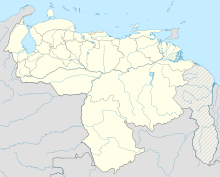| Battle of Urica | |||||||
|---|---|---|---|---|---|---|---|
| Part of Venezuelan War of Independence | |||||||
| |||||||
| Belligerents | |||||||
|
|
| ||||||
| Commanders and leaders | |||||||
|
José Félix Ribas José Francisco Bermúdez |
José Tomás Boves † Francisco Tomás Morales | ||||||
| Strength | |||||||
| 4,000 men | 7,000 men | ||||||
| Casualties and losses | |||||||
|
800–1,500 dead 500 prisoners killed | 800–1,000 dead | ||||||
 | |||||||
| Venezuelan War of Independence | |||||||||
|---|---|---|---|---|---|---|---|---|---|
| |||||||||
The Battle of Urica took place during the War of Venezuelan Independence in the village of Urica (in modern-day Anzoátegui) on 5 December 1814, between the forces of Republican general in chief José Félix Ribas and Royalist caudillo José Tomás Boves. Although Boves died, the Royalists won the battle.
Prelude
After the defeat in the Battle of Aragua de Barcelona, Simón Bolívar and Santiago Mariño were relieved of command by General Ribas on 2 September. In Cariaco he met with Colonel Manuel Piar, but mutual disagreements led them to divide their forces. Piar marched to Cumaná and was defeated by Boves in the Battle of El Salado [es] on 16 October.
Ribas had to march to Maturín to join up with Republican Colonel José Francisco Bermúdez. Together they decided to march to Urica to finish off Francisco Tomás Morales, Boves' second, who had previously been defeated by Bermúdez in the Fourth Battle of Maturín [es]. However, during the march they learned of Boves' proximity.
Ribas decided to retreat but Bermúdez refused and fought Boves in the Battle of Los Magüeyes [es] on 9 November. The colonel was defeated and his forces dispersed, weakening the Republicans.
After this battle, Bermúdez and his defeated army joined Ribas in Maturín.
In the meantime, Boves and his troops had linked up with the forces commanded by his lieutenant, Francisco Tomás Morales, in Urica.
Ribas for the Republicans commanded a force of 2,000, including José Tadeo Monagas, Pedro Zaraza, Manuel Cedeño, and Francisco Parejo. The Republican force deployed in three columns at dawn on December 5 on a plain near the town of Urica.
The battle
Boves led the first attack, targeting Bermúdez's column. This attack was repulsed, and heavy artillery fire inflicted casualties on the Royalist forces. Ribas ordered an attack and successfully encircled Boves' column on the Royalist right.
Boves, finding his column surrounded, led an attack by 400 cavalry in an attempt to break the Republican lines, but was killed in the fighting. The remaining unengaged Royalist columns encircled the Republicans, sealing a Royalist victory, although with heavy casualties on both sides.
Aftermath
Boves' death had far-reaching consequences. He was succeeded by Morales, but in the long run the llaneros he had led joined the Republican cause under the leadership of José Antonio Páez following efforts by the Republican criollo elite to attract mixed-race and lower class Venezuelans to the cause of independence.
References
- ^ González, Edgar Esteves (2004). Batallas de Venezuela, 1810-1824 (in Spanish). El Nacional. p. 83. ISBN 978-980-388-074-3. Retrieved 25 December 2023.
- ^ Duarte Level, Lino (1917). Cuadros de la historia militar y civil de Venezuela: desde el descubrimiento y conquista de Guayana hasta la batalla de Carabobo p.293. Madrid: Editorial América.
- Rafael María Baralt & Ramón Díaz (1841).
- Cipriano Heredia S. "El "Taita" Chávez".
Bibliography
- Antonio Núñez Jiménez (1994). A World Aside: Approximation to the History of Latin America and the Caribbean. Madrid: Editions of the Tower. ISBN 84-7960-043-8.